UPDATE:
Been a few years since I've last posted, but I haven't quit testing and growing baccy. Last year, although I've messed up in a variety of ways, the results couldn't have been better. Apparently I was a bit silly all the years before and now I've taken some pictures to show what I'm doing rather than merely relaying it with words.
First off, I've started planting far too late this year, leading me to do an emergency harvest in November. This was possible thanks to the fact that temperatures were unusually mild until then; normal harvesting time is August/September. The plants weren't quite there yet, but it was either that or writing the entire harvest off. Thought I might as well take my chances.
Due to the sheer volume and the fact that it was not a gradual replacement and additions, I had to dry a fair number of the leaves in the heating room. Utterly imperfect, but anywhere else I'd have got mould galore. Hence, I've had a fair bit flash-dry green.
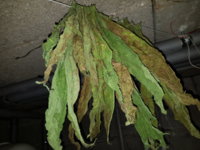
(Note: I didn't dry it bunched up like that, that's just for the picture, most of the leaves are either fermented or fermenting)
The first batch I did ended up smelling icky, like feces. Further fermentation didn't make them better, unfortunately. I presume it had less to do with the fact that some are still green, but rather because some leaves had begun to rot on the plant (it had started to get quite cold) and I missed them in my haste to solo-harvest upwards of 100 plants in one afternoon. Those were also the first ones to be dry and ready for fermentation.
I'm confident in this assumption, because the second batch, with more scrutiny applied to the leaves, had great fragrance and looked like this:
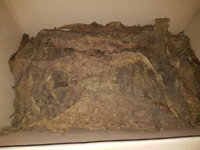
Giving a random leaf a test yesterday, it had a pronounced cigarry flavour, albeit very much on the light side concerning strength. Never had one quite like it; I don't know what factors contributed to it being this good. Might make a cigar at some point and see how it holds up. As of now, it's the closest thing tasting like a Spanish "Ducados", one of the brands I sought to emulate when I set out to grow my own years ago. I've forgotten which strain I used (busy year, tobacco obviously didn't receive as much attention as it should have), so it may have been that, too, effecting the flavour. Leafs are a bit darker than in the picture; the flash made them a lighter than they are. Colour variation ranges from the light brown up there to a near black. Yet. they're still inexplicably thin, regardless of where on the plant they were; many of them can be used as cigar/cigarillo wrappers. Done that, burns evenly without an issue, at least with shortfiller, dunno how it behaves with longfiller.
Perhaps I should've included it further up, but here's a break-down of my fermentation method with pictures:
The box itself looks like this, fairly simple design I've sawed crudely by hand:
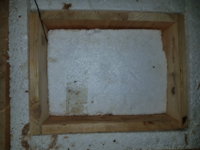
There's another lid covering this I didn't bother to take a picture of; the black cable is a heat sensor for the thermostat, which in turn regulates the heat cable.
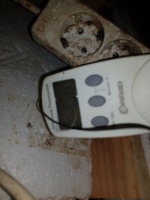
Thermostat reads 49.6°C (121,28°F) after opening the box. Never mind the dirt on the socket, had some renovation work throughout the basement that dusted everything with grime I haven't got around to cleaning yet everywhere.
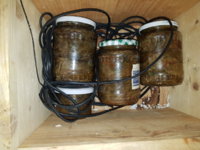
WIP, a bunch of leaves currently fermenting. I've changed my approach to a certain degree; to make life easier for myself and apparently also help fermentation, I've now taken to sorting the leaves according to size, rolling them up and stuffing them in there. Leaves are soaking wet, and I make sure there is as much moisture in there as possible. You wouldn't believe the number of leaves that fit in those jars, it's incredible. The black gunk you see at the bottom right is from liquid that has escaped from earlier fermentation batches. Smells like tobacco (duh) and it is rock-hard, impossible to remove. I've actually cut myself on it once because it'd stuck to the lid.
Leaves are deribbed, but fermentation with midrib is obviously possible. However, it risks tearing the leaves, making them unusable if you want to have cigar or cigarillo wrappers.
The heat cable enters through a hole I've drilled through the bottom; there's a lengthy unheated bit that leads outside to be plugged in, all the heatable surface is inside the box. Tried to get the sensor through there as well, but the hole was too tight and I was anxious not to lose too much heat. Once I've got the time, I'll redesign the box, putting the jars on a rack, suspended in the middle of the chamber. Additionally, I'll see to actually heating the entire chamber from multiple sides, so the jars get heated evenly to the desired temperature. The jars fortunately allow me to not care so much about the material I use, so I'll see what I'll come up with and how it works. Once I've got a new design that works, I'll post it here.

This jar has been in the box since Thursday last week, i.e. ~5 days. One thing I've figured out you need to be careful with is that if the jar is too full, a fair bit of the baccy might come your way when you open it. You can see it pressing against the lid up there. Apparently physics is still at play, meaning when you heat things up, they expand. And apparently, tobacco then acts like a jack-in-the-box; you've got a helluva time getting it back in. Hence, I only open the lid every other day, just slightly, to let some gases escape. After ~10 days or so, I take out all the baccy, add some moisture, and put it in for another stint until I like the odour I'm greeted with as well as the colour. All the green leaves shown initially turn brown or near black, without a hint at chlorophyll.
One thing I've figured out by now is that if you smoke it straight from the jar, it may still have a bit of a tangy taste. If you give it some time just sitting there in a box, it'll improve a bit. In other words, it can be used straight away to flavour cigarettes, but for smoking it pure, it needs a while for all the ick to dissipate and go through some cycles of changing ambient air humidity.








